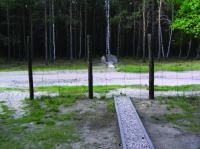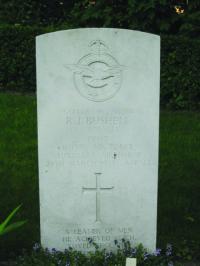THIS WEEK, 70 years ago, three British Airmen - Michael Codner, Eric Williams and Oliver Philpot - escaped from Stalag Luft III. This was the first successful escape from Stalag Luft III. It would not be the last.
Stalag Luft III was a POW camp located in the German province of Lower Silesia, near the town of Sagan (now Żagań in Poland), 100 miles southeast of Berlin. Since the camp was going to house downed Allied flyers, it was run by the Luftwaffe. It was first opened on March 21, 1942, and expanded several times thereafter. The North Compound, from which “The Great Escape” occurred, opened a year later. A South Compound for American flyers was opened in September 1943. The West Compound was opened in July 1944. Eventually the camp encompassed 60 acres and housed about 2,500 RAF officers, 7,500 Americans and 900 officers from other Allied air forces, for a total of 10,949 inmates.
The Germans had designed and located the camp to prevent escape by tunneling. The barracks were constructed with a space between the floor and the ground to allow the guards to observe if there was any tunneling under the barracks. The location of the camp was on land that had a very sandy subsoil. The sand was of a bright yellow consistence, easily detected when it was dumped on the ground, or even on someone’s clothing. Since it was very loose, it would be difficult to construct a tunnel because of the lack of structural integrity. Finally, the Germans placed seismographic microphones around the perimeter of the camp to detect any sounds of digging. The first year of its existence, the Germans had discovered and closed 40 tunnels and no one had escaped.
In the Spring of 1943, Lt. Michael Codner and Flight Lt. Eric Williams hit upon an escape scheme which involved building a vaulting horse from timber and plywood, which they stole and obtained from International Red Cross packages. All escape ideas had to be approved and “registered” with the “Escape Committee.” Oliver Philpot was the “Escape Coordinator” for the hut in which the three lived. At first, although he approved of the idea, Philpot thought that it was crazy.
The project began on July 8, 1943. As Williams and Codner hid inside the horse, a number of the prisoners carried it to a spot about 100 ft. from the camp wire. As Williams and Codner began to dig a tunnel below the horse, the rest of the prisoners vaulted for 2 - 3 hours at a stretch in a “keep fit exhibition.” Later, Philpot joined the two and began tunneling. The diggers used bowls to dig and after each digging session, the top of the shaft was covered with a piece of plywood, which was covered with the surface sand. The sand from the tunnel was carried back with the diggers in the horse. By the beginning of October, the tunnel was past the wire.
The three men planned their escape for Friday, October 29, 1943, which was a period of no moon. They had been digging for 114 days. That morning, Philpot and Codner were carried out to the tunnel in the horse as normal. Codner dug all day and remained in the tunnel through the evening role call. After the role call, Philpot and Williams and a third man, who was to cover the tunnel after the other two entered it, were carried back to the tunnel entrance in the horse. Just after 6:00 p.m., the three emerged on the free side of the fence. Philpot traveled as a Norwegian while the other two traveled as French workmen. All made their way to the Sagan railway station, where they caught a train to Frankfurt. From Frankfurt, Philpot went to Küstrin and thence to Danzig. At Danzig he stowed aboard the Swedish freighter, Aralizz. On November 4, 1943, he was taken into the British Legation in Stockholm and a week later, was reunited with his two compatriots, who had made it to Stettin and from there to Copenhagen and thence to Gothenberg in Sweden. In 1949, Williams wrote, “The Wooden Horse,” describing the escape.
Meanwhile, work had begun in the North Compound on “Tom,” “Dick” and “Harry.” These were the names given to the tunnels being dug under the supervision of RAF Squadron Leader Roger Bushell. The thinking was that if the Germans discovered one, they would relax their vigilance, never thinking that two more were, simultaneously, being dug. This was an immense undertaking, involving almost every prisoner in some aspect of the project. There were, of course, the diggers. There were also men involved in fashioning the necessary tools. An oxygen pump was also designed and fabricated. A group was assigned the task of dirt disposal. Another group was involved in fashioning civilian clothes. Still, another prepared the necessary travel documents. Finally, on Friday, March 24, 1944, 100 men assembled at “Harry.”
Seventy-six men made it out before the seventy-seventh was spotted. Of those, only three avoided recapture - Norwegians Pat Bergsland and Jens Müller and Dutchman Bram van der Stok - all captured while serving in the RAF. Initially, Hitler wanted them all executed. Dissuaded from that, over half were. The camp commandant, at the time, Friedrich Wilhelm von Lindeiner gennant von Wildau was replaced by Erich Cordes. In a scene recreated in the movie, “The Great Escape,” Cordes, on April 6, 1944, summoned the Senior British Officer, Herbert M. Massey, and informed him that he had been told that there had been some fatalities in the escape. When asked the number, Cordes replied “41.” The stunned Massey asked, “How many were wounded?” The German replied, “None.” He was mistaken. The number was 50. Cordes was later replaced by Franz Braune who was appalled at the executions and allowed a monument to be constructed, which still stands.
In the spring of 1944, British Foreign Secretary, Anthony Eden, reported the murders to Parliament, promising that those responsible would be, “...brought to exemplary justice.” In addition to British airmen, the victims included South Africans, Australians, Canadians, New Zealanders, Greeks, Czechs and Poles. After investigation, 72 were implicated, of which 21 were executed, 11 committed suicide, six were killed in the war and 17 were imprisoned. One was acquitted. Another died in Soviet captivity. The first trial, dealing solely with “The Great Escape” murders began on July 1, 1947 in No 1 War Crimes Court in Curio Haus in Hamburg against 18 defendants. Thirteen were sentenced to die and were hanged by British executioner Albert Pierrepoint, on February 27, 1948. The others were given prison sentences of varying lengths.
A fellow prisoner, Aussie Paul Brickhill, who did not escape, wrote the book, “The Great Escape,” from which the movie was adapted.
NEXT WEEK: BOUGAINVILLE
Mr. Wimbrow writes from Ocean City, Maryland, where he practices law representing those persons accused of criminal and traffic offenses, and those persons who have suffered a personal injury through no fault of their own. Mr. Wimbrow can be contacted at
wimbrowlaw@gmail.com.



